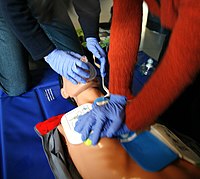
Photo from wikipedia
We introduce the use of buckled foam for soft pneumatic actuators. A moderate amount of residual compressive strain within elastomer foam increases the applied force ∼1.4 × or stroke ∼2 × compared… Click to show full abstract
We introduce the use of buckled foam for soft pneumatic actuators. A moderate amount of residual compressive strain within elastomer foam increases the applied force ∼1.4 × or stroke ∼2 × compared with actuators without residual strain. The origin of these improved characteristics is explained analytically. These actuators are applied in a direct cardiac compression (DCC) device design, a type of implanted mechanical circulatory support that avoids direct blood contact, mitigating risks of clot formation and stroke. This article describes a first step toward a pneumatically powered, patient-specific DCC design by employing elastomer foam as the mechanism for cardiac compression. To form the device, a mold of a patient's heart was obtained by 3D printing a digitized X-ray computed tomography or magnetic resonance imaging scan into a solid model. From this model, a soft, robotic foam DCC device was molded. The DCC device is compliant and uses compressed air to inflate foam chambers that in turn apply compression to the exterior of a heart. The device is demonstrated on a porcine heart and is capable of assisting heart pumping at physiologically relevant durations (∼200 ms for systole and ∼400 ms for diastole) and stroke volumes (∼70 mL). Although further development is necessary to produce a fully implantable device, the material and processing insights presented here are essential to the implementation of a foam-based, patient-specific DCC design.
Journal Title: Soft robotics
Year Published: 2018
Link to full text (if available)
Share on Social Media: Sign Up to like & get
recommendations!